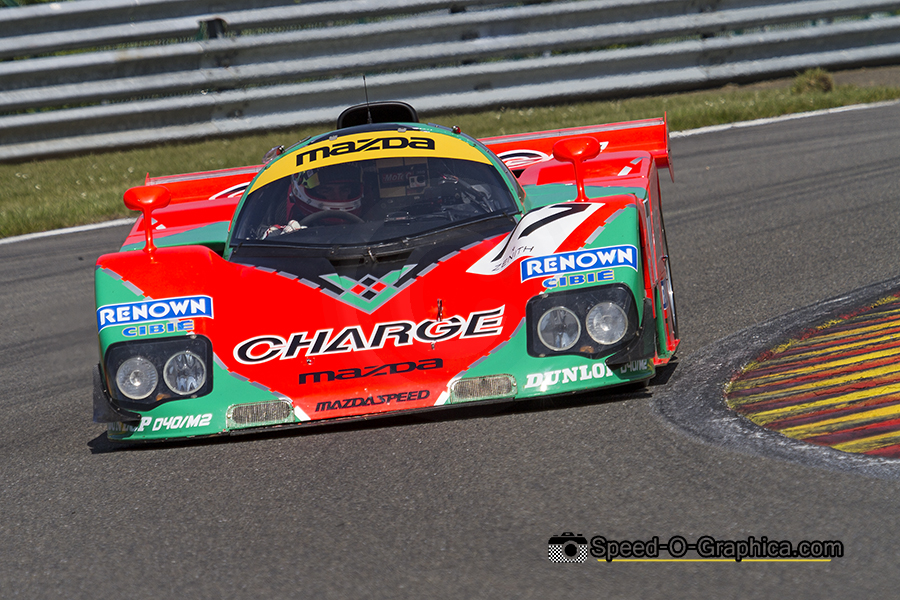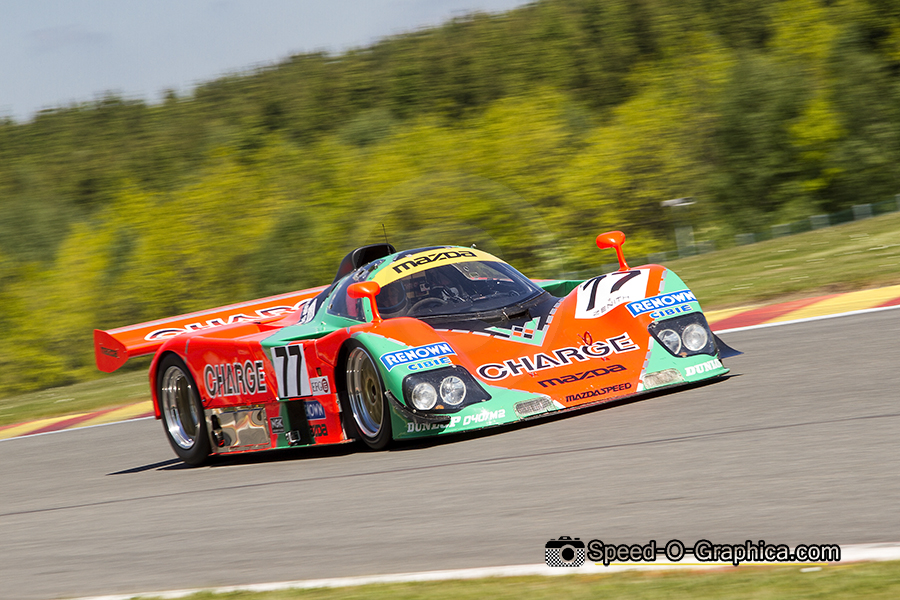Group C: The Rise and Fall of the Golden Age of Endurance Racing: Mazda part 2

Mazda 767 (chassis 767-003) driven by Max and Werner Moritz. The car was entered in Peter Auto’s Group C Racing series at the 2014 Spa Classic.
By Marcel Hundscheid / Speed-O-Graphica
Buckle up for our 12th part of the Group C retrospective, picking up with our look at Mazda’s efforts at Le Mans and in the World Sportscar Championship.
In this second part of our look at Mazda’s participation with a Group C racer in Le Mans we’ll take a closer look at the Mazda 767, 787 and finally the 787B. During six years of development, the five prototypes from Mazda all followed the same design concept – a compact two-seater monocoque combined with an engine and gearbox, which had a tilting suspension with tie rods at the front and double triangle arms at the rear.
Mazda’s 767 was developed with their new four-rotor rotary engine, although the chassis was based on the earlier 757 and turned out shorter. Mazda entered the 24 Hours of Le Mans in 1988 with two new 767s and an earlier 757. Although the two 767s fought their way to the top three, a cracked exhaust manifold and damaged gears at the water pump system hampered results.
Yoshimi Katayama, David Leslie and Marc Duez finished in 17th place in the nr. 201 Mazdaspeed 767, as Takashi Yorino, Hervé Regout and Will Houy finished in 19th place in the nr. 202 Mazdaspeed 767. The earlier 757 crossed the chequered flag in 15th position. As Mazda hoped for a better result, the Japanese manufacturer finished 1st, 2nd and 3rd in the IMSA GTP-class.
In 1989 Mazda grabbed class victories at Le Mans, winning the IMSA GTP Class for the third time in a row thanks to an improved Mazda 767B. The nr. 201 767B driven by David Kennedy, Pierre Dieudonné and Chris Hodgetts won the IMSA GTP Class and finished 7th overall. The nr. 202 car driven by Takashi Yorino, Hervé Regout and Ellio Forbes-Robinson finished 2nd in IMSA/GTP, 9th overall as Yojiro Terada, Marc Duez and Volker Weidler drove the nr. 203 767B to the final spot in IMSA/GTP, 12th overall.
Mazda’s final chance to participate in Le Mans with a rotary engine was 1990. The Japanese manufacturer threw everything they could at claiming victory, entering two 787s and a single 767B. All three cars suffered from technical problems and only the 767B saw the full distance, again claiming victory in the IMSA GTP class, despite finishing 20th overall.
However, at this point the manufacturers hadn’t been able to comply with the incoming regulation changes, which resulted in them being pushed back a further year and giving Mazda one more shot.

Mazda and Mazdaspeed developed a range of advanced technologies such as replacing the aluminium honeycomb structure with a variant of carbon composite and adjusting the aerodynamic properties of the car’s profile. Furthermore, the radiator was moved from the side of the body to the front. Mazda adjusted the aerodynamic shape of the car to better suit the 6 km long Hunaudieres Straight. The body was 50 mm narrower than that of the earlier 767B and together with the newly designed rear wheel arches the drag was reduced by 30%.
Mazda’s upgraded 787B was the factory’s final attempt to win Le Mans powered with a rotary engine. From the outside the 787B was only recognizable by a few minor changes, such as the size of the radiator outlets, air intake and slots in the body. Instead of speed, Mazda shifted their focus to maneuverability. Also new was the use of a carbon composite braking system, steel struts and increased wheels and tires.
Mazda entered two 787Bs and a single 787 and, although not a favorite for the overall victory, the cars started with a handicap as the new 3.5 liter cars were given the first grid positions. This resulted in a 19th, 23rd and 30th place on the starting grid. Two hours before the chequered flag was dropped the nr. 55 car grabbed the lead as the leading nr. 1 Mercedes C11 dropped back due to mechanical problems. In the end Johnny Herbert drove the nr. 55 car along with Volker Weidler en Bertrand Gachot to victory, making Mazda the first Japanese manufacturer to win the Le Mans 24 hours in history.

